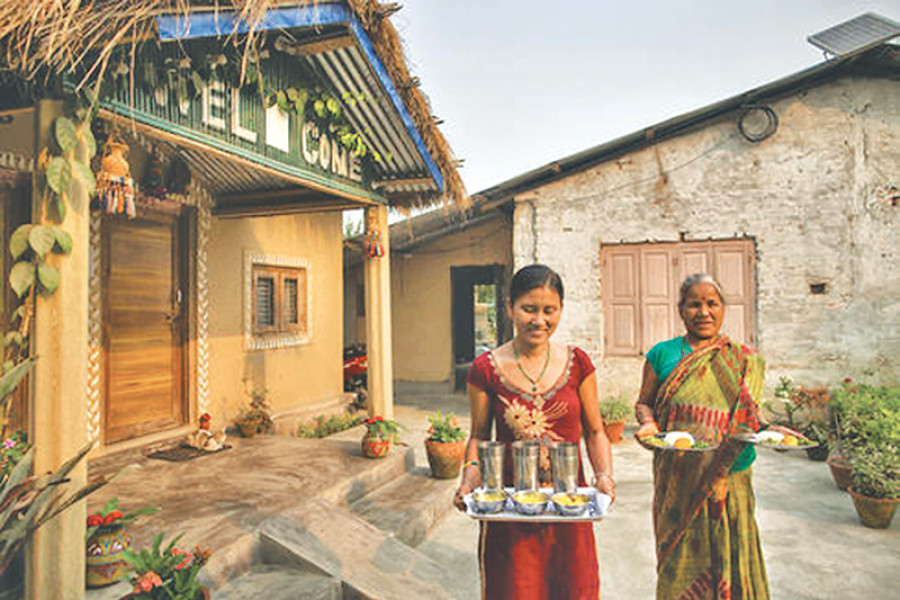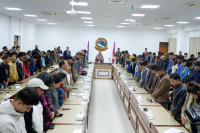Opinion
Sustainable tourism
The homestay programme in the Tarai Arc Landscape has been creating ample opportunities for wildlife conservation and for uplifting livelihoods of local people contributing to sustainable tourism.
Bharat Gotame
The homestay programme in the Tarai Arc Landscape has been creating ample opportunities for wildlife conservation and for uplifting livelihoods of local people contributing to sustainable tourism.
Nepal’s participatory conservation model has been recognised globally as one of the finest approaches for combining conservation and development. Nearly 24 percent of Nepal’s landmass is designated as protected areas and hosts 80 ecosystems out of 118 that are found in the country. Protected areas include national parks, wildlife reserves, conservation areas, hunting reserves and buffer zones which house vast biodiversity and provide multiple benefits to both human beings and wildlife.
Conservation and development
With the legalisation of the buffer zone concept in the mid-1990s, people residing in the buffer zones of national parks were recognised as important stakeholders in conservation and beneficiaries of nature-based tourism. National parks are primary tourist destinations. Although nature-based tourism claims a big share of revenue, some services provided by these protected areas are indirectly but uniquely valued by the communities and species living around them. However, the proliferation of mass tourism has resulted in communities getting minimal payback. Communities receive part of the entry fee paid by tourists; the larger benefits go directly to tourism entrepreneurs and hoteliers.
The concept of sustainable tourism rests on creating positive impacts on the environment, society and local people’s economy. The popular mass tourism being practised in Nepal, where the private sector has strong control over the benefits, shows that the environment and community livelihoods enhancement aspects are less prioritised. Nepal also lacks laws that address these issues and encourages the agenda of sustainable tourism.
To strengthen the motivation of local people in conservation by providing alternate livelihoods and wellbeing opportunities, WWF Nepal, together with the Government of Nepal (GoN), launched the Sustainable Communities Initiative in 2013 in Amaltari under the Tarai Arc Landscape program—a conservation approach jointly implemented by the GoN and WWF in six protected areas of the Tarai between Parsa Wildlife Reserve in the east to Shuklaphanta National Park in the west.
Under the Sustainable Communities Initiative, interventions like homestays, turmeric enterprises, bio-gas, community clinics and women-led micro-enterprises are benefitting both the forest-and river-dependent communities in Amaltari. The homestays that are being run in 22 houses of Amaltari are not only promoting sustainable tourism, but are serving as a major source of income for the communities to conserve biodiversity and foster the local economy in peri-urban and rural areas of the Tarai Arc. It has also helped reduce the direct pressure on biodiversity and has resulted in positive human-wildlife interaction while safeguarding the ecosystems.
There are currently 100 homestays with a capacity of 400 beds in 13 different sites in the Tarai Arc Landscape. With 22 homestays, Amaltari alone has seen more than 40,000 visitors in the last four years. This has enabled 22 families to generate a monthly gross revenue of about Rs20,000.
Community stewardship
Earlier, homestays were a means to expand an additional income base for local people in Amaltari but communities now have increased their engagement in handicrafts, fish, poultry and vegetable farming and so on.
Running homestay businesses not only generates new business opportunities for communities but also creates community stewardship in conservation. Production markets are expanding; more youths are getting employment and women have better access to local cooperatives that manage their savings. With more visitors in homestays, sanitation in the village improves, the market for locally produced agricultural products expands and local culture receives greater exposure. Hence, expanding nature-based tourism around the national parks of Nepal is likely to be a key approach in sustaining community participation in biodiversity conservation. However, increasing community benefits might not be enough to maintain the ecological integrity in the long run and improve the socio-economic well-being of local people. So, homestays are set as a new community enterprise approach to pay back the conservation efforts of local communities. They are seen as probably the best way to build community stewardship for conservation in Nepal and promote sustainable tourism.
Operational aspects of community homestays in the Tarai Arc are not the same as in private homestays. It involves broader aspects of sustainable development of communities, including conservation of natural ecosystems, socio-economic upliftment of local people and respecting local culture, norms and values. A portion of homestay revenue is invested in biodiversity conservation and community development, which means visitors are supporting biodiversity conservation and upgrading livelihoods of local people.
In Amaltari, 10 percent of gross income from the community homestay is used to support the community-based anti-poaching operations, maintaining the habitat in nearby community forest, campaigning for waste management in the village and supporting the re-enrolment of drop-out Musahar children in schools. In 2016, scholarships were provided to 16 Musahar children.
Community-based tourism in the Tarai Arc Landscape is low impact tourism, since homestays run their business by following the code of conduct prepared by the GoN’s Homestay Working Guideline 2010. Visitor’s satisfaction, minimum impact on biodiversity, contribution to local economy and respect to local culture are basic features for expanding wildlife tourism.
Given the recent achievements in Nepal’s conservation mission, expanding partnerships with communities is a dire need in today’s conservation approach, and community homestays could play a vital role. As a leading conservation organisation working with the GoN, WWF Nepal has been supporting local communities and has also been creating an enabling environment to foster local economy driven by wildlife tourism through community homestays. Sustainable tourism could also be particularly important in the new local governance structure if nature-based tourism is prioritised through a community-based tourism approach to build prosperous communities.
This year’s International Day for Biological Diversity is being celebrated with the theme of biodiversity and sustainable tourism. This day opens avenues for governments, conservationists, local communities and the private sector to work together in building awareness and promoting sustainable tourism as an important contributor, both to economic growth and to the conservation and sustainable use of biodiversity.
- Gotame is Senior Programme Officer at WWF Nepal




 20.12°C Kathmandu
20.12°C Kathmandu










